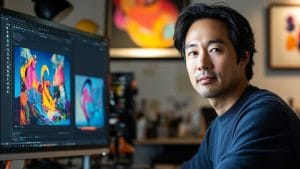
The union of computer graphics (CG) and artificial intelligence (AI) is transforming the production of digital content at a pace never before dreamed of. In video and film, in virtual reality (VR) and architectural visualization, AI is transforming how developers, engineers, and artists build interactive visual worlds. By eliminating the drudgery of process, taking advantage of greater realism, and enabling creators to open doors of new potential, AI is not only rationalizing processes but actually making the very parameters of possibility viable in computer-generated imagery.
This article by Kirill Yurovskiy discusses the critical role of AI in contemporary computer graphics, and it includes extensive coverage of key technology advances, commercial applications, and the ethical challenges that go with them. As AI continues to advance, its integration into CG will revolutionize entertainment, design, and interactive media beyond our imagination today.
1. Milestones in 3D Graphics and Animation
Computer graphics production is marked by constant innovation from the initial crude drawings of wireframe models to current photorealistic animation. AI sped up this process by adding intelligent automation to it. Neural rendering technologies such as NVIDIA’s Instant NeRF can now recreate 3D worlds from 2D images in real-time, reducing environment modeling time by orders of magnitude.
They are also simplifying the expense and technicality of top-end graphic development, making single artists and monster studios equally enabled.
2. AI-Driven Design: Concept to Render
AI is automating the entire creative process from concept art right through to final render. AI programs like MidJourney and DALL-E allow artists to rapidly prototype concepts by getting text prompts translated into sophisticated concept art. Such software is particularly valuable at pre-production when being able to rapidly create characters, environments, and props saves on development time by substantial amounts.
In 3D modeling, technology like Kaedim utilizing AI can turn doodles in 2D into completed 3D assets that require less sculpting. AI also simplifies rendering performance—NVIDIA’s OptiX and other methods of denoising use deep learning to make ray tracing go faster, so iteration can be made faster without sacrificing quality. AI makes tedious labor repetitive, enabling artists to accomplish more imagination and innovation.
3. Procedural Generation: Reducing Manual Labor in CG
Procedural content generation through AI is changing the construction of digital worlds. Instead of laboriously hand-crafting each detail, game makers can employ AI tools to generate automatically vast, diverse landscapes, intricate textures, and even subtle building shapes. No Man’s Sky exemplifies procedural generation functionality, producing effectively unlimited planetary systems with ecologies uniquely varied, and algorithmically generated.
With advancements in AI algorithms, procedural generation will be increasingly applied to game development, filmmaking, and virtual world construction.
4. Techniques of Realistic Lighting, Texturing, and Shading
Computer graphics photorealism relies on the ability to model light, texture, and material interaction realistically. AI is advancing immensely in this regard with algorithms like Neural Radiance Fields (NeRF), which map real-world lighting conditions and reflect them in virtual reality. The technology is of immense utility in high-fidelity applications like special effects for films and product visualization.
These technologies are closing the gap between computer graphics and reality, allowing levels of immersion that were previously unimaginable.
5. Collaboration on International CG Pipelines
Modern CG production is generally a time zone and studio-distributed workflow. AI is making collaboration with ease possible by allowing optimized cloud-based rendering, automatic versioning, and real-time feedback loops. AWS Deadline Cloud is one product that utilizes AI for streamlined render farm management and optimization of the utilization of computational resources to where they are most needed.
These advances are revolutionizing global cooperation among groups and making possible cost-cutting and more agile production streams.
6. Motion Capture and Real-Time Virtual Productions
Artificial intelligence revolutionized motion capture technology by eliminating the laborious marker-based systems. Today’s AI technology has the capability of scanning video content and delivering accurate captures without requiring physical sensors, thereby making performance capture usability and flexibility superior. Independent movie producers and computer game developers working on low-budget projects are most impacted by the technology.
Motorized virtual production cycles allow the director to have elaborate scenes ahead of them when shooting on location, reducing the inconvenience of post-production and facilitating more experimenting with the imagination.
7. Convergence of Gaming, Film, and AR/VR
Blurs between video games, film, and virtual reality (XR) are being removed assisted in large part by artificially generated images. Artificial intelligence adds realism to video games with physics dynamic simulations, intelligent NPC behavior, and responsiveness to story. The film industry, on the other hand, is making more use of game engine technology in virtual production, i.e., for The Lion King (2019) and Avatar: The Way of Water.
With the continued development of AI technology, we can expect a greater blending of these media and new means of entertainment and interactive storytelling.
8. Ethical Issues: Deepfakes and Digital Cloning
Although AI holds unimagined creative power, it also holds pressing ethical issues. Deepfakes, to consider one option, can construct hyper-real but completely false-looking clips, and their stakes range from misinformation to identity theft. The film industry must contend with the consequences of digitally resurrecting the images of actors, especially as it grapples with consent and post-mortem work issues.
Bias in AI technology is another possibility—if training data are representative, the worlds and characters produced will perpetuate stereotypes. Regulation and ethical guidelines practice must be implemented such that AI is not being utilized irresponsibly for computer graphics. Transparency of AI-generated material, e.g., watermarking deepfakes, can mitigate some of the above risks.
9. Education and Skill Development in AI-CG
With more and more computer graphics being driven by AI, people who are better capable of using such technology are being hired. Colleges and websites are incorporating AI into their CG courseware to compensate. College courses in AI-animated animation can now be found, and internet sites like Coursera and Udemy offer inexpensive tutorials on software like Blender’s AI plugins.
Open-source AI initiatives also lower the barriers to entry so that new artists and programmers can try out new approaches. By developing a new generation of AI-savvy artists, the industry can set up the next wave of innovation without compromising top-level artistry and technical quality.
10. Forecasting the Next Wave of CG Advances
The potential of computer graphics and AI is limitless. Generative AI will write and animate a feature film alone someday, and AI-powered holographic screens may bring 3D into our reality without headsets. Brain-computer interfaces can also make immersion even more immersive because virtual worlds are controlled by neural input.
Quantum computing has the potential to open up new realms for real-time rendering, allowing for simulations of unimagined scale. More intuitive and innovative AI models have the potential to become more than mere tools and move into collaborators and partners in their own right, aiding the artist in ways not yet conceived.
Conclusion
The convergence of AI and CG is taking us to a new generation of photorealistic, interactive visual experiences, from virtual reality immersive to cinema. Where we stand here at the threshold of this revolution, one thing is certain: the future of computer graphics will be one of the union of human imagination and artificial intelligence, and the possibilities will be as boundless as thrilling.





